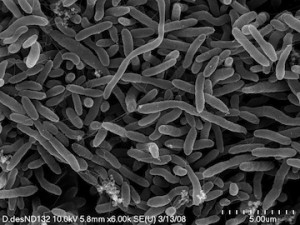
A bacterium called Desulfovibrio desulfuricans strain ND132 can transform elemental mercury into methylmercury, a human neurotoxin. Credit: Oak Ridge National Laboratory.
A newly decoded bacterial genome brings scientists one step closer to unlocking the secret behind the production of methylmercury, the chemical notorious for contaminating tuna and other seafood.
Most mercury pollution comes from the burning of fossil fuels. Once in the atmosphere, it seeps into the rain and gradually trickles down to the sea. Certain bacteria that thrive in sediments and soils then transform it into methylmercury, a much more dangerous neurotoxin which latches onto proteins and works its way up the food chain. Though industries and regulators have made concerted efforts to curtail mercury’s release, its effects still linger in ecosystems across the globe.
Not many bacteria are capable of making methylmercury, and the exact workings of the process remain shrouded in mystery.
“We know a little about the bacteria that produce methylmercury, but we don’t know the mechanism by which they produce it,” says Cynthia Gilmour, a co-author of the paper and senior scientist at the Smithsonian Environmental Research Center in Edgewater, Md.
Scientists still don’t know which genes and proteins allow certain bacteria to make the transformation, says lead author Steven Brown of Oak Ridge National Laboratory in Tennessee. With this genome complete, Gilmour says they can contrast it with the DNA of bacteria that don’t produce methylmercury to see which genes are different.
Gilmour isolated this particular strain of bacterium 25 years ago in the sediments of the Chesapeake Bay. Officially known as Desulfovibrio desulfuricans strain ND132, it flourishes in sediments with no oxygen, often found in marshes, streams and wetlands. Microorganisms like this breathe sulfate rather than oxygen and produce most of the methylmercury in the world. The genome sequence was published this month in the Journal of Bacteriology.
“This is the very first genome that we have for a bacterium that makes methylmercury,” Gilmour says. Scientists hope by understanding the basic science behind methylmercury’s production, they can find ways to reduce its harmful effects on the environment and human health.
The genome was sequenced at the Department of Energy’s Joint Genome Institute in Walnut Creek, California, and completed at Oak Ridge National Laboratory. Scientists from the University of Missouri also contributed to the work.
-by Kristen Minogue

